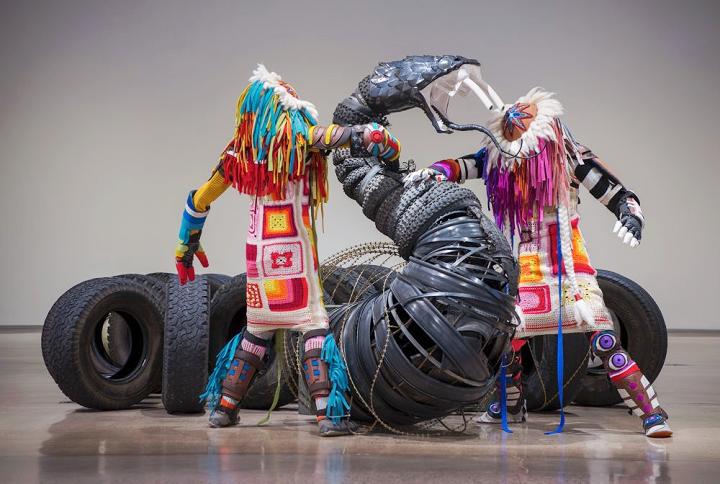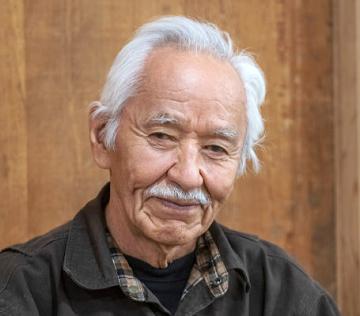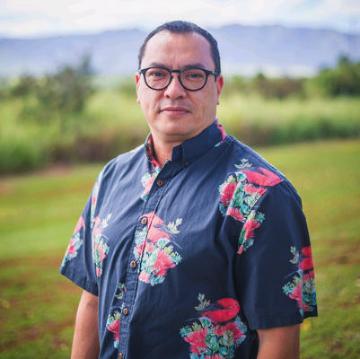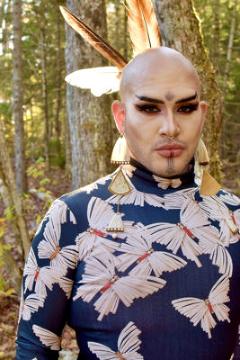|
|
|
"This Is Not
A Snake / The One Who Checks & The One Who Balances,"
by Cannupa Hanska Luger, 2017-2020. Ceramic, riot gear, fiber,
steel, oil drums, concertina wire, ammunition cans, trash,
found objects, beadwork, surplus industrial felt, afghan,
dimensions: 6.5 × 3 × 50 feet. (Craig Smith; courtesy
of Heard Museum)
|
The United States Artists (USA) fellowship announced winners last
week, which included six Indigenous artists from across the country.
Sixty artists across ten creative disciplines and 22 states, as
well as the District of Columbia and Puerto Rico, were each awarded
a $50,000 fellowship.
Artists were awarded fellowships in the following disciplines:
Architecture & Design, Craft, Dance, Film, Media, Music, Theater
& Performance, Traditional Arts, Visual Art, and Writing.
Four of the Indigenous artists were featured in the Traditional
Arts section, and one each was awarded in the Craft and Dance sections,
respectively.
|
|
Nathan Paul Jackson (Chilkoot-Tlingit)
earned a fellowship in Traditional Arts for his woodcarving
and sculptural art. He was raised in southeastern Alaska near
the Haines area and is part of the Sockeye Clan on the Raven
side of the tribe and is now based in Ketchikan, Alaska. He
has worked as a freelance artist and woodcarver as well as a
woodcarving and design instructor at the Alaska State Museum,
Sheldon Jackson College, the Totem Heritage Center, and the
University of Alaska. He participates in the Native Apprenticeship
Program and has several apprentices working under him, and is
currently working on a totem project in Saxman, a Native village
two miles south of Ketchikan. To date, he has carved more than
50 totem poles, some of which can be found in museums and private
collections, and smaller items such as masks. |
| Delina White (Minnesota
Chippewa, Leech Lake Band of Ojibwe) is a Walker, Minn.-based
Anishinaabe apparel designer and beadwork artist featured in
the Traditional Arts category. She has been making heirloom
beadwork and apparel to celebrate traditional ceremonies for
“as long as she can remember,” and is interested in
the intersection of “color, texture, composition, and construction
of fabric” based in her culture with today’s contemporary
fashion, such as dresses, bags and footwear. “White approaches
art as a way to wear the pride, dignity, and distinction of
the original Great Lakes and Woodlands people,” her USA
profile page says. |
|
|
|
Kawika Lum-Nelmida (Hawaiian)
is a hulu (feather) artist from Pupukea, O'ahu, Hawai'i, based
in Honolulu. He was awarded a fellowship in the Traditional
Arts category. Lum-Nelmida started learning about feather adornments
in 1997 during his Bachelor of Arts in Natural Environment and
Fiber Arts at the University of Hawai'i at Manoa. Since 2012,
he has been a participant in MAMo: Maoli Arts Movement, a program
of the PA?I Foundation. In 2013, Lum-Nelmida was awarded an
apprenticeship with Kahalepuna (recipient of 2014 MAMo and 'Õ'õ
awards) through the Hawai'i State Foundation on Culture and
the Arts, which he used to study Hawaiian feather work in the
forms of lei (adornment), kahili (feather standard), ahu'ula
(cape), and mahi'ole (helmets), and how to use, cultivate, and
preserve traditional materials. He has also used modern materials
to create contemporary art and worked on clothing design. Lum-Nelmida’s
work was featured in the annual MAMo Wearable Art Show. |
| Geo Soctomah Neptune (Passamaquoddy)
is a basketmaker based in Motahkomikuk, Maine. They are a “drag
queen, activist, educator, and two-spirit — an Indigenous
cultural, spiritual, and gender role that holds the sacred space
between masculine and feminine energies,” their USA profile
says. They earned a fellowship in the Traditional Arts category.
Neptune has been weaving since they were four years old, learning
under their grandmother, Molly Neptune Parker, and began teaching
with the Maine Indian Basketmakers Alliance at 11 years old.
At 20, Neptune became the youngest person to receive the title
Master Basketmaker. “After graduating from Dartmouth College
in 2010, they returned home and began developing their individual
artistic style of whimsical and historically informed basketry
and woven jewelry. With their grandmother’s influence clearly
visible in their work, Neptune shows the closeness that the
two shared and the lifelong education they received through
her teachings,” their USA profile says. Neptune has worked
with Wabanaki communities towards cultural preservation, and
also statewide with Maine schools to educate about Indigenous
history. |
|
|
|
Cannupa Hanska Luger (Mandan,
Hidatsa, Arikara, Lakota) is a multidisciplinary artist based
in Glorieta, N.M. He was awarded the USA fellowship in the Craft
category. Luger was raised on the Standing Rock Reservation
in North Dakota. His projects take many forms and incorporate
ceramics, video, sound, fiber, steel, and repurposed materials
with the aim “to communicate stories about twenty-first-century
Indigeneity” and provoke “audiences to engage with
Indigenous peoples and values apart from the lens of colonial
social structuring and often presents a call to action to protect
land from capitalist exploits.” Luger is a 2020 Creative
Capital Fellow, a 2020 Smithsonian Artist Research Fellow, and
the recipient of the Center for Craft’s inaugural Craft
Research Fund Artist Fellowship (2020), a Joan Mitchell Foundation
Painters & Sculptors Grant (2019), and the Museum of Arts
and Design’s inaugural Burke Prize (2018). He has exhibited
internationally at venues such as the Gardiner Museum in Toronto,
Art Mûr in Quebec, Kunsthal KAdE in Amersfoort, Netherlands,
Crystal Bridges Museum of American Art in Bentonville, Ark.,
and the National Center for Civil and Human Rights in Atlanta.
Luger holds a BFA in Studio Arts from the Institute of American
Indian Arts and is represented by Garth Greenan Gallery in New
York. |
| Emily Johnson (Yu’pik)
is a New York-based dancer who was awarded a USA fellowship
in the Dance category. Johnson is also a Bessie Award-winning
choreographer, Guggenheim Fellow and recipient of the Doris
Duke Artist Award, and “since 1998 has created work that
considers the experience of sensing and seeing performance,”
her USA profile says. “Her dances function as portals and
care processions; they engage audienceship within and through
space, time, and environment — interacting with a place’s
architecture, peoples, history and role in building futures.
She is trying to make a world where performance is part of life,
where performance is an integral connection to each other, our
environment, our stories, our past, present, and future.”
Johnson is also a land and water protector and hosts monthly
ceremonial fires on Mannahatta in partnership with Abrons Arts
Center and Karyn Recollet. She is part of an advisory group
developing a First Nations Performing Arts Network. |
|
"We are grateful for every artist whose artmaking, music,
writing, and more is helping us to navigate and cope through this
harrowing time in our country," said United States Artists
President and CEO Deana Haggag in a statement. “The 2021 USA
Fellows are a testament to the power of art in shaping the world
around us and navigating its complexities. Artists do so much for
our communities, and we are grateful to be able to support these
60 incredible practitioners and welcome them into the United States
Artists fellowship.”
The $50,000 fellowships can be used without restrictions and are
supplemented by financial advising programs to help the winners
“maximize the benefit of this prize,” USA said in a press
release.
“Since 2006, the USA Fellowship has provided direct support
to artists across the country. With this unrestricted award, Fellows
decide for themselves how to best use the money — whether it
is creating new work, paying rent, reducing debt, getting healthcare,
or supporting their families,” USA said.
“Artists are at the core of their communities, and as the
difficulties of the past year have demonstrated, it is more important
than ever that we continue to support individual artists,”
said Ed Henry, USA Board Chair, in a statement. “And as we
continue to meet the challenges 2021 will bring, it is also clear
that USA must remain nimble and responsive to the needs of the field,
which is why we are honored to be able to support the largest cohort
in our history with 60 artists this year.”

United
States Artists
In 2003, the Urban Institute conducted a study which revealed that
96% of Americans valued art in their lives, while only 27% valued
artists.* Motivated by the study and in response to the NEA’s
severe budget cuts, four inspiring leaders of the Ford, Rockefeller,
Rasmuson, and Prudential Foundations spearheaded the launch of an
organization to illuminate the value of artists to American society
and address their economic challenges.
https://www.unitedstatesartists.org
|










